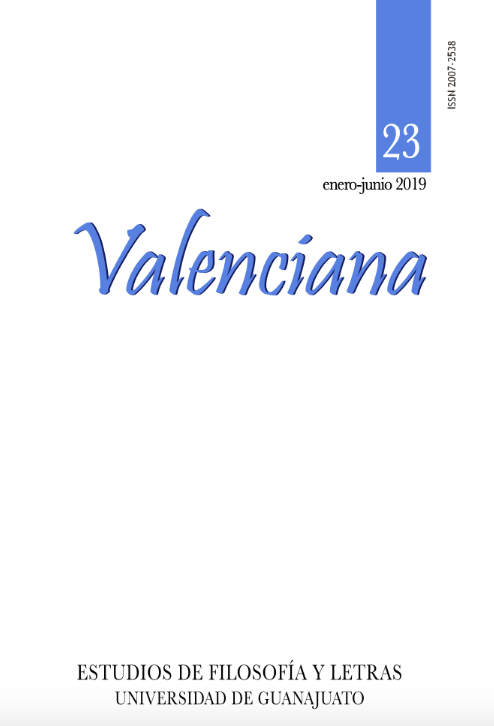Textualización de la verdad y crisis de la tradición en El castillo, de Franz Kafka
DOI:
https://doi.org/10.15174/rv.v0i23.386Resumen
El objetivo de este artículo es identificar en la escritura / lectura de Franz Kafka, a partir de El Castillo, la intersección entre la problemática de la crisis de la tradición, planteada por Walter Benjamin y Gershom Scholem, y la textualización de la verdad que se desprende de las prácticas exegéticas en la tradición mística del judaísmo, sobre todo en la teoría cabalística del lenguaje. Siguiendo la discusión de las principales teorías presentes en el referencial bibliográfico, analizaremos cómo la escritura en Kafka se utiliza del comentario como método, fundiendo exégesis y creación literaria. Podemos concluir que la verdad, en Kafka, se encuentra inseparable del texto y del comentario, lo que nos remite al Nombre de Dios infinitamente interpretable vislumbrado por la tradición mística de la Cábala. En la escritura de Kafka, la verdad inseparable del laberinto de interpretaciones apunta a la crisis de la tradición como característica esencial de su modernidad, expresando los límites entre religión y nihilismo.
Citas
Alter, Robert, 2002, Anjos necessários: tradição e modernidade em Kafka, Benjamin e Scholem, trad. Andre Cardoso, Imago, Rio de Janeiro, 167 p.
Anders, Günther, 2007, Kafka: Pró e contra, trad: Modesto Carone, CosacNayf, São Paulo, 161 p.
Arendt, Hannah, 2005, La tradición oculta, trad. R. S. Carbô y Vicente G. Ibáñez, Paidós, Buenos Aires, 176 p.
Benjamin, Walter, 1987, Magia e técnica, arte e política, trad. Sergio Paulo Rouanet, Brasiliense, São Paulo, 256 p.
_____, 1987b, Rua de mão única, trad. Sergio Paulo Rouanet, Brasiliense, São Paulo, 277 p.
_____, 2007, Sobre el lenguaje en cuanto tal y sobre el lenguaje del hombre, en Obras, libro II/vol. I, trad. Jorge Navarro Pérez, Abada Editores, Madrid, 426 p.
Benjamin, W.; Scholem, G., 1987, Correspondência 1933-1940, trad. Francisco Rafael L. González, Trotta, Madrid, 277 p.
Blanchot. Maurice, 2002 De Kafka a Kafka, trad. Jorge Ferreiro, Editora Nacional, Madrid, 213 p.
Campani, Carlos, 2011, Fundamentos da Cabala: Sêfer Yetsirá, Editora UFPEL, Pelotas, 346 p.
Forster, Ricardo, 2008, "La cabála y la travesía del mal" en Revista Digital de Estudos Judaicos, Belo Horizonte, v. 2, n. 3, out, 2008, pp. 55-66.
Idel, Moshe, 2007, "Jacques Derrida and kabbalistic sources", en Judeities: Questions for Jacques Derrida, Fordhan University Press, EUA, pp. 111-138.
_____, 1989, Language, Torah, and Hermeneutics in Abraham Abulafia, State University of New York Press, New York, 212 p.
Jonas, Hans, La religión gnóstica, trad. Menchu Gutierrez, Siruela, Madrid, 416 p.
Kafka, Franz, 2010, O Castelo, trad. Modesto Carone, Companhia das Letras, São Paulo,368 p.
_____, 1997, O Processo, trad. Modesto Carone, Companhia das Letras, São Paulo, 272 p.
_____, 1997, Carta ao pai, trad. Modesto Carone, Companhia das Letras, São Paulo, 88 p.
_____, 1953, Diarios, trad. J. R. Wilcock, Emecé, Buenos Aires, 509 p.
_____, 2003, Obras Completas III: Narraciones y otros escritos, trad. Jordi Llovet, Galaxia de Gutenberg, Espanha, 1222 p.
_____, 1990, Cartas aos meus amigos, trad. Patricia Fonseca, Nova Época, São Paulo, 192 p.
Lecler, Éric, 2013, L’Absolu et la littérature: du romantisme allemand à Kafka, Classiques Garnier, Paris, 337 p.
Löwy, Michael, Utopia e Redenção, trad. Paulo Neves, Companhia das Letras, São Paulo, 205 p.
Milmaniene, Magalí, 2007, La tradición mesiánica judía ya la influencia de Gershom Scholem en la obra de Walter Benjamin, Tese (Universidad de Buenos Aires), 128 p.
Mòses, Stéphane, 1997, El ángel de la historia: Rosenzweig, Benjamin, Scholem, trad. Alicia Martorell, Cátedra, Madrid, 221 p.
Scholem. Gershom, 2001, La Cábala y su simbolismo, trad. Carlos Peleiro, Siglo XXI, México, 227 p.
_____, 2008, Conceptos basicos del judaismo, trad. Jose Luis Barbero, Trotta, Madrid, 139 p.
_____, 2001, Los orígenes de la cábala, trad. Radamés Molina y Cesar Mora, Paidós, Barcelona, 183 p.
_____, 1999, Judaica III, trad. Ruth Joana Solon y Jacob Guinsburg, Perspectiva, São Paulo, 229 p.
Torrents, José, 2000, Los gnósticos, Gredos, Madrid, 418 p.
Willer, Claudio, 2010, Um obscuro encanto: gnose, gnósticos e poesia moderna, Civilização Brasileira, Rio de Janeiro, 462 p.
Publicado
Cómo citar
Número
Sección
Licencia
Política de acceso abierto
Los autores/as que publiquen en esta revista aceptan las siguientes condiciones:
De acuerdo con la legislación de derechos de autor, Valenciana reconoce y respeta el derecho moral de los autores, así como la titularidad del derecho patrimonial, el cual será cedido a la revista para su difusión en acceso abierto. Valenciana no realiza cargos a los autores por enviar y procesar artículos para su publicación.
Todos los textos publicados por Valenciana –sin excepción– se distribuyen amparados bajo la licencia Creative Commons 4.0 Atribución-NoComercial-SinDerivadas 4.0 Internacional (CC BY-NC-ND 4.0), que permite a terceros utilizar lo publicado siempre que mencionen la autoría del trabajo y a la primera publicación en esta revista.
Los autores/as pueden realizar otros acuerdos contractuales independientes y adicionales para la distribución no exclusiva de la versión del artículo publicado en Valenciana (por ejemplo incluirlo en un repositorio institucional o publicarlo en un libro) siempre que indiquen claramente que el trabajo se publicó por primera vez en Valenciana.
Por lo anterior, los autores deberán firmar una carta de autorización mediante la cual ellos conservan los derechos de autor pero garantizan los derechos de primera publicación de sus artículos vía red de cómputo e impresa a la revista Valenciana. Estudios de filosofía y letras y a la Universidad de Guanajuato.
Es posible realizar reproducciones parciales de los artículos siempre y cuando se respete la propiedad intelectual siguiendo la debida forma de citación.
Queda estrictamente prohibida la reproducción total de la revista Valenciana sin previa autorización de la Universidad de Guanajuato.

Los trabajos publicados en esta revista están bajo una Atribución-NoComercial-SinDerivadas 4.0 Internacional (CC BY-NC-ND 4.0).










